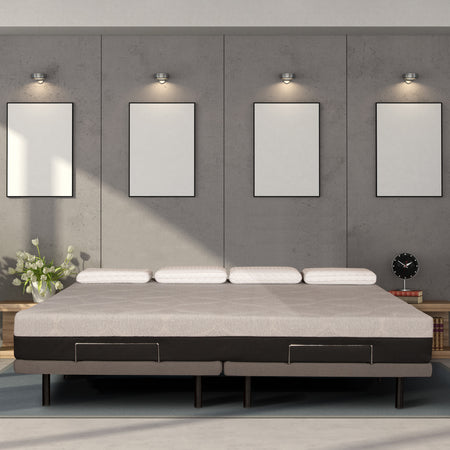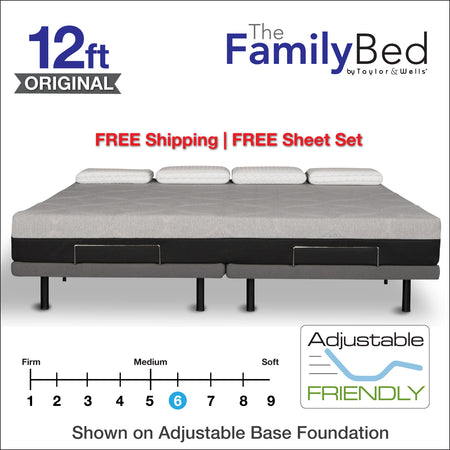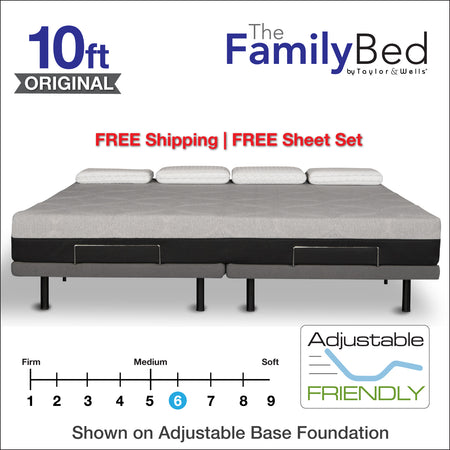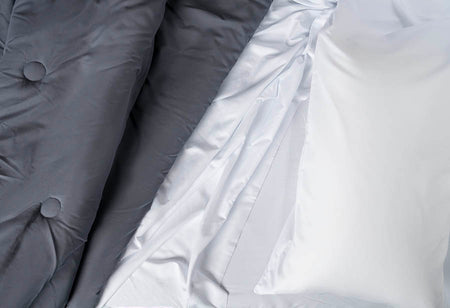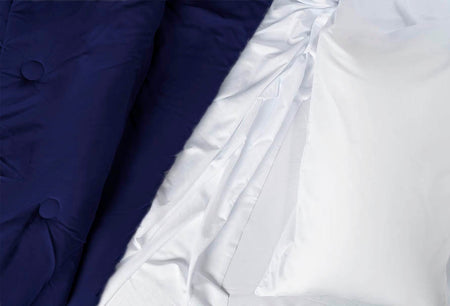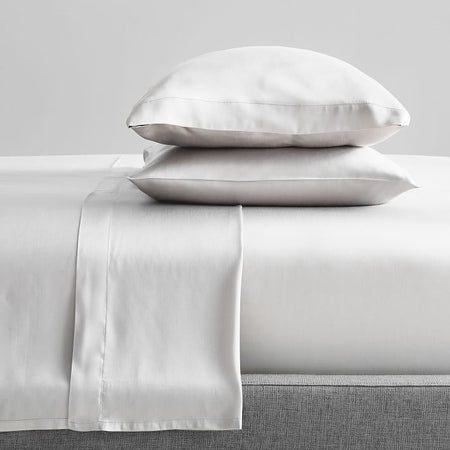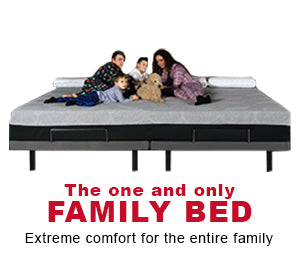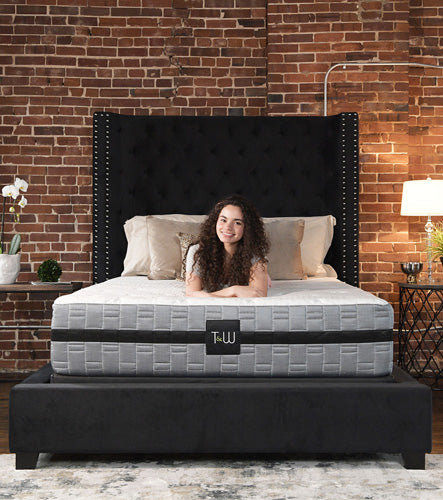Mattress off-gassing refers to that distinctive “new mattress smell” you might notice after unboxing a bed. When you open a freshly manufactured, vacuum-sealed mattress and place it on your bed frame, you may detect a chemical-like odor in the room. This happens because volatile organic compounds (VOCs) are released from the mattress materials into the air.
In simple terms, off-gassing is the process of a new mattress emitting these leftover manufacturing fumes. It’s especially common with mattress-in-a-box products that are compressed and vacuum sealed right after production (the packaging traps those VOCs until you open it). The smell can be unpleasant, but what does it mean for your health and indoor air quality?

Why Do New Mattresses Smell?
That “new mattress smell” is largely caused by VOCs escaping from synthetic materials in the bed. VOCs are chemicals that easily evaporate at room temperature. They’re found in many household items (paint, new furniture, carpets, etc.), and mattresses are no exception.
Foam layers (such as polyurethane memory foam) and certain adhesives used in mattress assembly are common sources of VOC emissions. As these materials release gases, you catch a whiff of that factory-fresh odor.
Not all VOCs are harmful, and the mere presence of a “new” smell doesn’t automatically mean danger. In fact, many VOCs in mattresses are emitted at very low levels considered safe for indoor air. However, some specific compounds can be irritating or unhealthy in higher concentrations.
For example, mattresses (especially synthetic materials) might emit traces of chemicals like formaldehyde, benzene, toluene, or acetaldehyde, which are known to have short- and long-term health effects at sufficient exposure levels.
Formaldehyde, in particular, is classified as a known carcinogen and can cause respiratory issues with prolonged exposure. The good news is that reputable mattress manufacturers have greatly reduced or eliminated the worst offenders: high-quality foams today are often made without formaldehyde and other toxic additives and tested to meet strict emission limits.

Side Effects: Who Might Be Sensitive to Off-Gassing?
Most people find off-gassing smells annoying, but some individuals are more sensitive to them. If you’re especially sensitive to smells or chemicals, you might experience mild side effects from a strongly off-gassing mattress. These can include short-term headaches, nausea, or lightheadedness.
The initial fumes could irritate the airways, leading to coughing or breathing discomfort for people with asthma, allergies, or other respiratory issues. Children and babies are also more vulnerable – not only do they breathe more air relative to their body weight, but they often sleep many hours (and very close to the mattress surface), which increases exposure.
It’s important to put this in perspective. The odor can be unpleasant, but off-gassing odors pose no known serious health risks for most adults. Typically, any irritation or symptoms go away as the smell dissipates. VOC emissions are highest after unboxing and reduce significantly within the first few days.
Chemical testing shows that a mattress “breathes out” the strongest fumes in the first 24-48 hours, after which the levels fall off quickly as the VOCs get released into the air and ventilated away. If you don’t have a particular sensitivity, you might only notice a “new foam” smell and nothing else. But if you feel uncomfortable, it’s a sign to give the mattress a bit more time to air out (and ensure good room ventilation) before you snooze on it.
Materials Matter
How much a mattress off-gasses depends on its materials. Synthetic materials like polyurethane memory foam and polyfoam release more VOC emissions, especially when used in cheaper models or with strong adhesives. These VOCs are responsible for that typical “factory” smell, which can linger for days in some beds. Additionally, the glues or adhesives used to bond foam layers can emit VOCs (even water-based glues have some mild smell).
In contrast, natural materials like organic latex off-gas far less, at most, giving off a mild, harmless scent. Innerspring mattresses release fewer odors due to minimal foam content and good airflow. Hybrid mattresses vary: those with thick memory foam may off-gas lightly, while hybrids using latex or limited foam offer minimal smell.
If you’re worried about off-gassing, you might lean toward mattresses advertised as low VOC or those made of natural components. Look for certifications like CertiPUR-US® Certified foam, which indicates the foam is made without harmful chemicals (no formaldehyde, no heavy metals, no prohibited phthalates) and has low VOC emissions (less than 0.5 parts per million) for better indoor air quality.
Other labels like GREENGUARD Gold or OEKO-TEX also ensure strict limits on chemical emissions. These third-party certifications can give you peace of mind that the product won’t fill your bedroom with a chemical cloud. It’s been tested to off-gas below established safety thresholds.
It’s worth noting that even a high-quality memory foam mattress that’s CertiPUR-US certified might initially have a slight smell. Certification doesn’t mean zero off-gassing, but it does mean the total emissions are very low and within safe levels. In other words, a certified foam bed will air out quickly, and any odor should be minor and short-lived compared to cheaper foams.

Tips to Minimize Off-Gassing (and That New Mattress Smell)
If you’re opening a new mattress and worried about odors, there are some simple steps to protect your health and make the off-gassing period as short and easy as possible:
-
Ventilate the room: Place the new mattress in a well-ventilated space. Open windows, turn on a fan, or temporarily move the mattress to a guest room or garage if possible. Fresh air circulation will help carry away VOCs faster.
-
Unbox and wait: It’s tempting to sleep on your new bed immediately, but if you’re sensitive to smells, give it a day or two to “breathe.” Most off-gassing occurs in the first 24-48 hours. Unwrap the mattress and let it expand in an open area; the initial stronger odors will dissipate significantly within this time frame.
-
Keep the room temperature moderate: Heat can cause VOCs to release more rapidly. In fact, studies have shown that body heat can increase VOC emissions from a mattress while you sleep. A warm room or high room temperature might initially intensify the smell. So, try to keep the room at a comfortable, mild temperature and ventilated as the bed airs out. (Don’t worry – once the off-gassing slows down, you can enjoy your cozy, warm bedroom as usual.)
-
Use baking soda (optional): Sprinkling an open mattress with baking soda and then vacuuming it after a few hours can help absorb odors. This isn’t always necessary, but some find it helpful for particularly smelly memory foam. Ensure the mattress is fully dry and expanded before applying.
-
Protective covers: Using a mattress protector or breathable cover after the initial airing-out can help seal any remaining odors away from you. Just ensure the worst smell is gone; you don’t want to trap moisture. And choose a cover made of safe materials (avoid covers with PVC/vinyl that could have their own VOCs – breathable cotton or polyurethane laminate covers are better).
Should You Be Worried About Off-Gassing?
For most people, mattress off-gassing isn’t dangerous, but it can be mildly unpleasant. The amount of VOC emissions from a new mattress is typically low and well within safe limits, especially if the mattress meets modern environmental standards. Once it airs out, your room’s indoor air quality returns to normal, and that “new bed smell” will fade.
That said, people with asthma or allergies, respiratory issues, or chemical sensitivities may notice short-term irritation. Babies and young children, who sleep more hours and are more vulnerable to toxins, also benefit from high-quality, low-emission mattresses.
To protect your health, choose mattresses made from natural materials like organic latex, wool, or cotton, or opt for memory foam mattresses that are CertiPUR-US® Certified. This label guarantees the foam is free from harmful synthetic materials like formaldehyde, heavy metals, or PBDE flame retardants, and has low VOC emissions for safer sleep.
USA-Made Mattresses and Lower VOC Emissions: Why Quality Matters
If you want peace of mind when it comes to materials and emissions, go with a made in USA mattress. Brands that manufacture domestically must comply with strict safety rules on flammability, durability, and chemical content. Plus, many US companies exceed these regulations, offering added transparency and better quality control. One standout example is Taylor & Wells, a high-quality, luxury mattress line handcrafted in Fort Worth, Texas.
What makes Taylor & Wells special is their hands-on manufacturing process. Every material, from the foam layers to the fabric, is carefully selected and tested in-house. Their mattresses use only CertiPUR-US® Certified foam, which is low in VOC emissions, free from ozone-depleting substances and flame retardants like PBDEs, and safer for both people and the planet. This dramatically reduces off-gassing and minimizes the risk of breathing in toxic fumes.
At Bedding Mart, we carry a full collection of Taylor & Wells mattresses. If you’re all about comfort, health, and indoor air quality, then visit us online or in-store and buy a mattress that lets you rest easy from night one.


